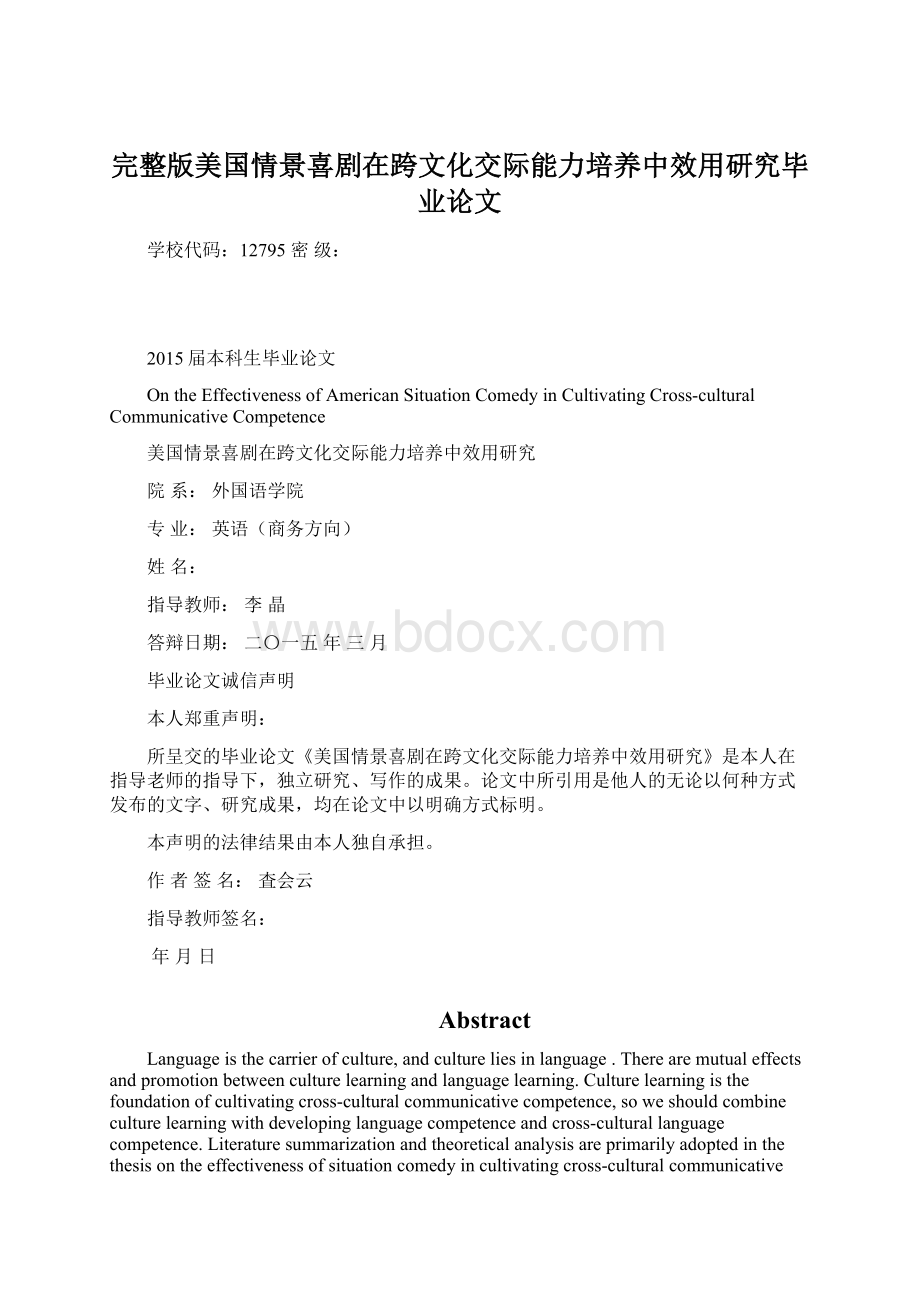完整版美国情景喜剧在跨文化交际能力培养中效用研究毕业论文Word文档下载推荐.docx
《完整版美国情景喜剧在跨文化交际能力培养中效用研究毕业论文Word文档下载推荐.docx》由会员分享,可在线阅读,更多相关《完整版美国情景喜剧在跨文化交际能力培养中效用研究毕业论文Word文档下载推荐.docx(19页珍藏版)》请在冰豆网上搜索。

院系:
外国语学院
专业:
英语(商务方向)
姓名:
指导教师:
李晶
答辩日期:
二〇一五年三月
毕业论文诚信声明
本人郑重声明:
所呈交的毕业论文《美国情景喜剧在跨文化交际能力培养中效用研究》是本人在指导老师的指导下,独立研究、写作的成果。
论文中所引用是他人的无论以何种方式发布的文字、研究成果,均在论文中以明确方式标明。
本声明的法律结果由本人独自承担。
作者签名:
査会云
指导教师签名:
年月日
Abstract
Languageisthecarrierofculture,andcultureliesinlanguage.Therearemutualeffectsandpromotionbetweenculturelearningandlanguagelearning.Culturelearningisthefoundationofcultivatingcross-culturalcommunicativecompetence,soweshouldcombineculturelearningwithdevelopinglanguagecompetenceandcross-culturallanguagecompetence.Literaturesummarizationandtheoreticalanalysisareprimarilyadoptedinthethesisontheeffectivenessofsituationcomedyincultivatingcross-culturalcommunicativecompetence.TheauthordiscusseshowtobondcultureteachingandlanguageteachingbyappreciatingthefilmsandTVplaysinclasstoimprovelearners’cross-culturalcommunicativecompetence,andtheauthoranalyzescommonproblemsofEnglishlearnersandcross-culturalcommunicativebarriersandhowtoavoidorevensettletheseproblems.SituationcomediesarepopularwithagreatdealofEnglishloversbecauseofhumorousdialoguesandpureEnglish.Students’pragamaticcompetencecanbeimprovedthroughsituationcomedies’assistanceinEnglishteachingforpromotingtheircross-culturalcommunicativecompetence.
【Keywords】situationcomedy;
cross-culturalcommunicativecompetence;
appreciationoffilmsandTVplays
摘要
语言是文化的载体,文化蕴含于语言之中。
语言学习和文化学习相互影响,相互促进,而培养跨文化交际能力的基础正是文化的学习,所以在文化学习的过程中我们应该把文化学习与语言能力发展和跨文化语言能力发展结合起来。
本文主要采用文献回顾法和理论分析法研究情景喜剧对大学生跨文化交际能力的培养的效用,探讨英语影视鉴赏课如何把文化教学与语言教学两者结合来提高学习者的跨文化交际能力,分析当代学生学习英语的普遍问题和跨文化交际的多种障碍以及从影视剧欣赏的角度探讨如何避免甚至解决这些问题。
情景喜剧因为非常精彩幽默的对白和地道纯正的英语口语而深受广大英语爱好者的青睐。
因此在英语教学中,通过情景喜剧的辅助,可以有效提高学生的语用能力,从而最终使得他们的跨文化交际能力得到提高。
【关键词】情景喜剧;
跨文化交际能力;
影视剧欣赏
Contents
AbstractI
摘要II
Contents..................................................................................................................................III
ChapterOneIntroduction1
1.1Background1
1.2Significance1
1.3Structure2
ChapterTwoLiteratureReview2
2.1SituationComedy2
2.2Cross-culturalCommunication3
ChapterThreeLanguageandCulture5
3.1Language5
3.2Culture6
3.3RelationsbetweenCultureLearningandLanguageLearning8
ChapterFourCross-culturalCommunicativeCompetence10
4.1CommunicativeCompetenceandCross-culturalCommunicativeCompetence10
4.1.1Communicativecompetence10
4.1.2Cross-culturalcommunicativecompetence11
4.2Cross-culturalCommunicativeAwareness12
4.3Cross-culturalCommunicativeBarriersandCultivation14
4.3.1Cross-culturalcommunicativebarriers14
4.3.2Cross-culturalcommunicativecultivation15
ChapterFiveImprovingCross-culturalCommunicativeCompetenceinSituationComedy16
5.1CommonProblemsofEnglishLearning16
5.2AppreciationofFilmsandTVPlaysinCultivatingCross-culturalCommunicativeCompetence18
5.3ApplicationofSituationComedyinClass20
ChapterSixConclusion22
References24
Acknowledgements25
ChapterOneIntroduction
1.1Background
Thecommunicationsbetweenpeoplefromdifferentsocialculturesandregionshavebeenmoreandmorefrequentowningtotheglobalization.Communicatingincrosscultureisanobviousfeatureoftheglobalizingworldwheretheneedsforinternationaltalentswithspecializedknowledgeandgoodcross-culturalcommunicativecompetenceareveryurgent.Fiercerculturaldiversityandtheconflictbetweenthosecultureshavebeenconfrontingamongcontemporarycollegestudents.Thosequestionshowtobuildcross-culturalcommunicators’qualitysystemandhowtocultivateinternationaltalentswhocanadapttotheirnationaldevelopmentareimportantissuestobeurgentlysolvedforhighereducation.Itisimportantanddifficultforuniversitypersonneltrainerstoprovidethecountrywithglobaltalentswhopossessspecializedknowledgeandinterculturalcommunicativecompetenceanddirectlyparticipateininternationalexchangesandcompetitions,andmeetnewrequirementsfortalentedpersonproposedbyinternationalcommunity.Withmoreemphasisputonbothlanguageteachingandcultureteaching,thereareanincreasingnumberofinsiderswhodonotsimplythinklanguageteachingasimpartinglanguageknowledgebutcombinelanguagecompetencetogetherwithcross-culturalcommunicativecompetencefordevelopingstudents’competencetoflexiblyuseculturalknowledgeincross-culturalcommunicativesituations.
1.2Significance
Filmsarefromlifeandcanreflectthenationalcultureandcontributegreatlytounderstandingthetargetlanguageculturebetter.Consequentlyappreciatingfilmswouldbeonekeychanneltoinputcultureandexportculture.Originalmovieseriescanmakeclassatmosphereeasy,andcollegeEnglishteachersshouldmakefulluseofthemediatobooststudents’learningenthusiasmandexpandtheunderstandingofwesternculture,whichistoimprovestudents’cross-culturalcommunicativecompetence.Plotsinsitcomsareveryamusingandinteresting.Inaddition,theirlinesarelargelyclassicandhumorous.Teachingwithsituationcomediescaneasestudents’anxiety,whichnotonlybuildsacomfortablestudyingenvironment,arousinglearningpassion,butalsocreatesanoccasionallaughsothatstudentsfallintoinitiativeandactivestudyinghabitssoastomeettheultimategoaltoimprovelearners’interculturalcommunicativecompetence.
1.3Structure
Thethesisconsistsofsixchapters.Thefirstchapterisintroduction,includingbackgroundandsignificanceandstructureofthethesis.Thesecondchapterisliteraturereview.Thethirdchapterintroduceslanguageandcultureandtherelationsbetweenlanguagelearningandculturelearning.Thenthefourthpartindicatesbrieflycommunicativecompetence,cross-culturalcommunicativecompetence,cross-culturalcommunicativeawarenessandcross-culturalcommunicativebarriersandcultivation.Thefifthchapterdiscussestheimprovementofcross-culturalcommunicativecompetenceinsituationcomedy,anditreferstothreepartsasfollows:
commonproblemsofEnglishlearning,appreciationoffilmsandTVplaysincultivatingcross-culturalcommunicativecompetenceandapplicationofsituationcomedyinclass.Finally,thesixchapteristheconclusionofthethesis.
ChapterTwoLiteratureReview
2.1SituationComedy
Situationcomedy,alsocalledsitcoms,isonetypeofcomedyfeaturingfeaturesthatsharesthefixedcommonsetting,likeonecoffeeshoporanapartmentorahouse,withnowandthenjokesasonekindofdialogue(苏莉杰,2012).Althoughthistypeofprogramshasrootsinradio,nowsituationcomediescanonlybefoundontelevisiontoagreatextent.Morespecifically,sitcoms,involvingafixedcastofactorsinonesuccessionofepisodes,areeitherradiosetortelevisionseriesofcomedies.Besides,frequentlyallthesecharactersaredramaticallyvariousformsgatheredtogetherbysituationsaswellassharingthesamesurroundingssuchasahomeoraparticularapartment.Usuallysituationcomediesareinlengthhalfanhour,wheretheplotisdesignedtocovertotalingtwenty-twominutesindurationandadditionaleightminutesforanothercommercialuse.Furthermore,insitcomsthestoryiseitheremployingplottedapplauseortapinginadvanceofastudioaudience,whichisnotedbyverbalargumentsandquicklysettledconflicts.
WilliamAsherhasbeenknownasagreatpersonwhoinventsthesituationcomedy,inadditionwhohasguideddozensofthemajorsitcomsinAmerica.Invariousperiods,Americansituationcomediesshowdiscriminatingcharactersfrom1950stonowinthemiddleoftheirdevelopingprocess.Inthenineteenfiftiesfamilycomediesandworkplacecomediesweretwogenresofinitialsitcoms.Morefantasticcomponentswereaddedintoliveactionsituationcomediesbysitcomsinventortillthemiddleofthe1960s.What’smore,beforenineteensixtiesAmericansitcomswerenotfilmedinfrontoftheliveaudiencesbutpost-producedaprerecordedlaughter.Situationcomediesgetdowntoaddressingalargeamountofcontroversialissuesintheinitial1970saswellasmostlygobacktothethree-camerasysteminfrontofliveaudience.AsforAmericansitcomsinthe1980s,plentifulAmericansituationcomedieslikeGrowingPainsreturnedtofamily;
theirmaintopicsareaboutparentsandchildren,neverthelesstherewerefewpoliticalissuesinvolvedinthesitcoms.Tillthemiddleofthe1990songoingplotlineswereappliedinsomesituationcomedies.Friends,awell-knownsitcom,applyanelementofsoapopera,forexample,thecast’srelationsarebuiltlittlebylittleovertheprocessoftheallstories.
2.2Cross-culturalCommunication
Cross-culturalcommunicationstudiesthewaythatpeoplefromaroundtheworldandvaryingintheirculturalenvironmentorbackgroundsexchangeandcommunicateeachotherproperly,inadditiontohowtheystrivetocompleteitinterculturalcommunicationwell(胡文仲,1999).Diversecultureswillinevitablyconfrontandthenconflict,finallycombinewitheachotherwiththeworldglobalization,peculiarlythegrowingofworldcommerce.Itisnotonlylanguageobstaclesbutalsoculturalfeatureswillaffecttheprocessofcommunicationamongpeopleindifferentareas.
Asiswell-known,EdwardHallinhisSilentLanguage(1959)firstmentionscross-culturalcommunication.Inthe1960s,theintellectualsincommunicationconceptualizedcross-culturalcommunication.Agreatdealofpublishedworksreflectsaquickprogressinthefieldduringthe1970s.Beinginte